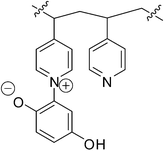Studies on photocatalytically active materials containing structure elements of a pyridinium alkaloid from Punica granatum
Abstract
The alkaloid

* Corresponding authors
a
Clausthal University of Technology, Institute of Organic Chemistry, Leibnizstrasse 6, D-38678 Clausthal-Zellerfeld, Germany
E-mail:
schmidt@ioc.tu-clausthal.de
Fax: +49-(0)5323-722858
Tel: +49-(0)5323-723861
b University of Konstanz, Fachbereich Chemie, D-78457 Konstanz, Germany
The alkaloid

 Please wait while we load your content...
Something went wrong. Try again?
Please wait while we load your content...
Something went wrong. Try again?
A. Schmidt, M. Albrecht, T. Mordhorst, M. Topp and G. Jeschke, J. Mater. Chem., 2007, 17, 2793 DOI: 10.1039/B701612C
To request permission to reproduce material from this article, please go to the Copyright Clearance Center request page.
If you are an author contributing to an RSC publication, you do not need to request permission provided correct acknowledgement is given.
If you are the author of this article, you do not need to request permission to reproduce figures and diagrams provided correct acknowledgement is given. If you want to reproduce the whole article in a third-party publication (excluding your thesis/dissertation for which permission is not required) please go to the Copyright Clearance Center request page.
Read more about how to correctly acknowledge RSC content.
 Fetching data from CrossRef.
Fetching data from CrossRef.
This may take some time to load.
Loading related content
